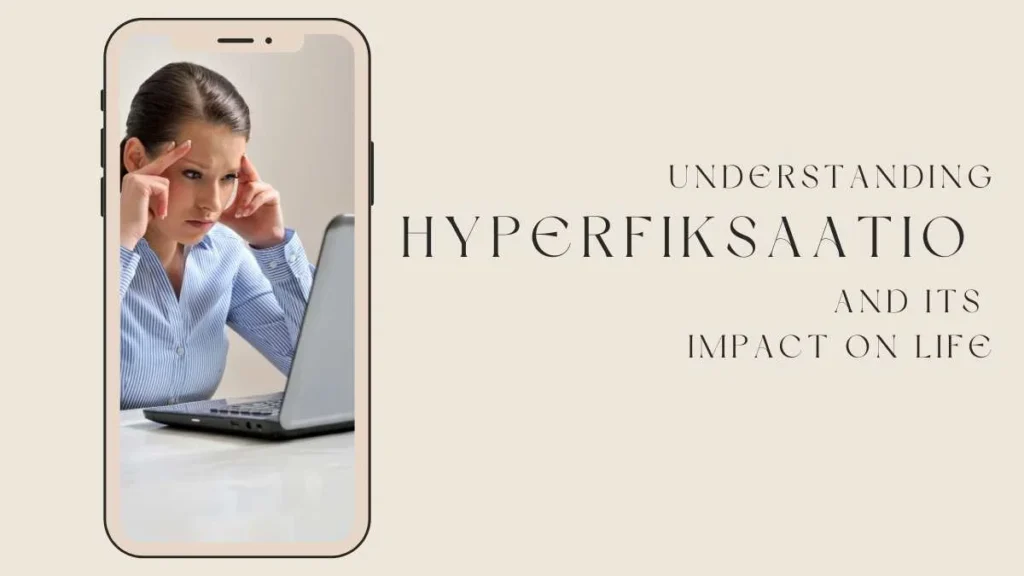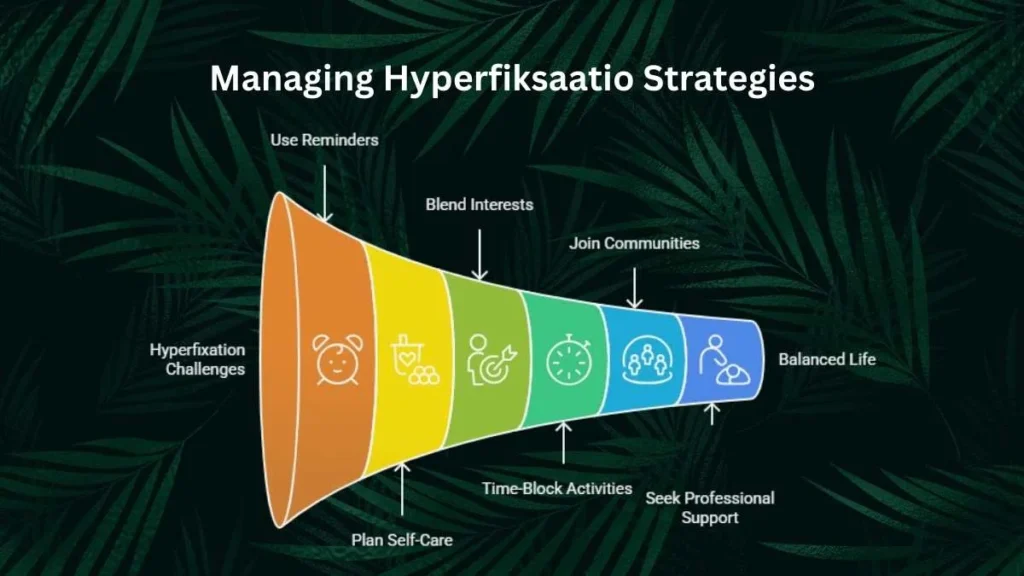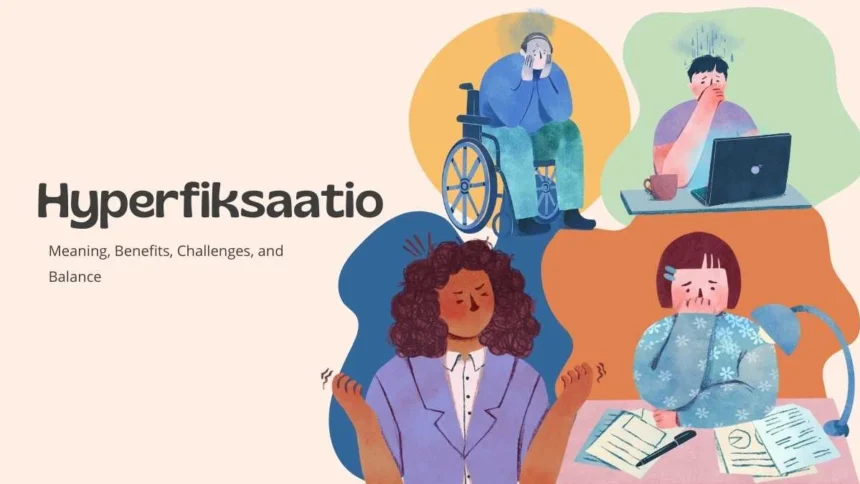Hyperfiksaatio is the Finnish word for hyperfixation, a state where someone becomes intensely focused on a specific interest, activity, or subject. This deep concentration can last for hours or even days, often making people forget about daily needs like sleeping, eating, or finishing tasks.
So, what is hyperfiksaatio really? It is not simply a strong focus; it is a unique mental state often linked with ADHD, autism, and other forms of neurodivergence. While it brings joy, creativity, and comfort, it may also create challenges if left unmanaged. Understanding this phenomenon helps people embrace its strengths while minimizing its drawbacks.
What Does Hyperfiksaatio Look Like?
At its core, hyperfixation is a state of deep concentration where a person becomes fully absorbed in an activity, interest, or thought pattern, often for hours or even days. Unlike ordinary focus, it is marked by intensity and duration that can be difficult to interrupt, sometimes leading individuals to lose awareness of basic needs like eating, sleeping, or personal hygiene. While immersed, many experience feelings of joy, comfort, and calmness, yet find it mentally exhausting or frustrating to shift their attention elsewhere. Though not inherently negative, hyperfiksaatio can fuel creativity, mastery, and resilience, but without balance, it may contribute to burnout, stress, or imbalance in daily life.

Hyperfiksaatio and Neurodivergence
Hyperfixation is commonly discussed in relation to neurodivergent conditions like ADHD and autism, though it can be experienced by anyone.
In ADHD
- Individuals with ADHD often struggle with sustained attention in areas that do not stimulate them.
- However, when they encounter something that deeply engages their brain’s reward system, they can enter hyperfocus, a related phenomenon to hyperfixation.
- Hyperfiksaatio in ADHD may be short-lived but intense, shifting from one fixation to another over time.
In Autism
- Autistic individuals often have special interests, deep, passionate focuses that can last for years.
- Hyperfiksaatio in autism may overlap with these interests, driving expertise, and comfort.
- These fixations often provide structure, emotional regulation, and identity.
In Other Conditions
Hyperfiksaatio can also appear in conditions such as OCD or anxiety disorders, though the underlying motivation differs. For example:
- In OCD, focus may stem from compulsions or intrusive thoughts.
- In anxiety, hyperfixation may act as a coping mechanism to escape stress.
Positive Impact of Hyperfiksaatio
Hyperfiksaatio is not always a problem; it can actually be an asset.
- Skill growth: Hours of practice can lead to mastery in art, coding, music, or sports.
- Productivity: People may finish projects faster when in this state of flow.
- Comfort: Fixations create a safe space during stress.
- Community: Shared passions often lead to friendships and support groups.
Many creative breakthroughs and careers have grown out of someone’s hyperfixation.
Challenges That Come With It
While valuable, hyperfixation can cause disruptions in daily life.
- Neglect of basic needs like eating or resting.
- Missing deadlines, chores, or social commitments.
- Exhaustion or mental burnout after long sessions.
- Frustration or irritability when interrupted.
- Feelings of guilt after realizing time has been “lost.”
Practical Ways to Manage Hyperfiksaatio
Finding balance is the key. Here are strategies people use:
- Use reminders: Set alarms or gentle timers to take breaks.
- Plan self-care: Keep snacks and water nearby, and commit to small routines.
- Blend interests into goals: Channel fixations into school, work, or personal growth.
- Time-block activities: Use methods like Pomodoro to mix focus with rest.
- Join communities: Share interests with others to avoid isolation.
- Seek professional support: If hyperfixation affects life heavily, therapists can help.

Hyperfiksaatio vs. Flow
People often confuse hyperfixation with flow state.
| Aspect | Flow State | Hyperfiksaatio |
| Duration | Usually limited | Can last hours or days |
| Control | More flexible | Harder to stop voluntarily |
| Relation to tasks | Often linked to performance goals | May not align with external priorities |
| Connection to needs | Balanced with breaks | Can override sleep, meals, and routines |
Language and Cultural View
The Finnish term hyperfiksaatio reflects how language shapes understanding. While English uses “hyperfixation” informally, Finnish integrates it into mental health conversations, signaling greater recognition of neurodiverse thinking patterns.
This broader cultural awareness reduces stigma and encourages acceptance of different cognitive styles.
Balancing Hyperfiksaatio in Life
To embrace hyperfiksaatio as a positive force, balance is essential. It begins with self-compassion, recognizing that hyperfixation is not a flaw but a natural way some brains work. Finding balance means allowing time for fixations while still meeting essential responsibilities, and practicing adaptability by accepting that interests may evolve, fade, or shift over time. Equally important are support systems, since family, friends, and workplaces can play a crucial role in understanding and accommodating these deep focus states. When approached with awareness and healthy boundaries, hyperfiksaatio can shift from being a source of struggle to becoming a powerful tool for creativity, learning, and fulfillment.
FAQs
Q1: Can hyperfiksaatio help with career choices?
Yes, many people turn their fixations into successful careers by channeling passion into expertise.
Q2: Is hyperfixation always linked to neurodivergence?
No, while common in ADHD and autism, anyone can experience hyperfiksaatio.
Q3: Can children experience hyperfiksaatio differently from adults?
Yes, children often show it through intense play or hobbies, while adults may channel it into work or research.
Conclusion
Hyperfiksaatio is more than strong focus; it is a deep, often joyful immersion in something meaningful. For people with ADHD, autism, or even outside neurodivergence, it can be both empowering and overwhelming.
When balanced with boundaries and self-care, hyperfixation transforms into a source of growth, mastery, and comfort. Recognizing and respecting it fosters not only personal well-being but also a more inclusive view of human diversity.






